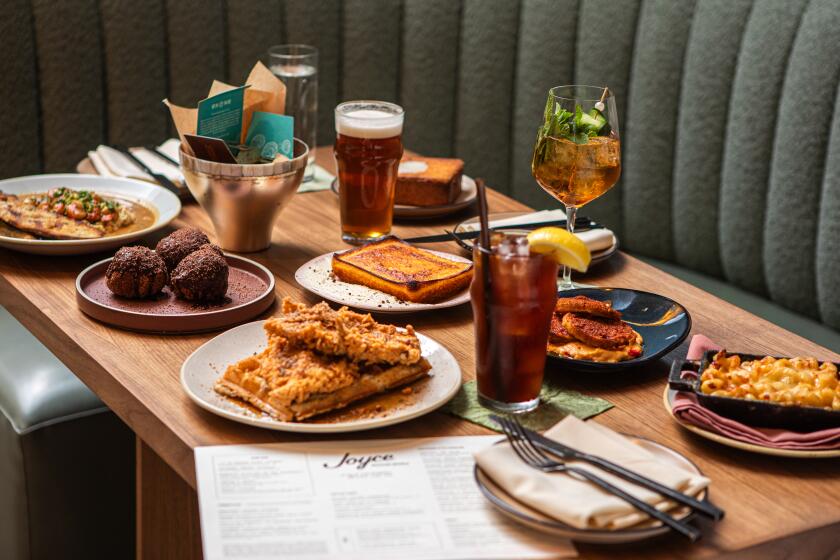Vintners Cut Prices on Lower Demand
A surplus of many types of wine is pressing the nation’s vintners to cut prices--reversing the trend during the wine boom of the last few years.
Weaker demand after Sept. 11 and more intense competition from imported wines has made it harder for wineries to move inventory, analysts say. Consequently, more wineries are lowering prices, offering special promotions or rolling out some of their wine in much larger bottles.
“There is a lot of wine out there to sell right now,” said Gladys Horiuchi, spokeswoman for the Wine Institute, an industry trade group in San Francisco. “It’s highly competitive, so many are having to compete on price.”
Indeed, Horiuchi said, the wine market is more competitive than it has been in a decade, as a strong dollar has made imports cheaper and helped secure these wines more space on supermarket shelves.
Imports’ share of the U.S. market has risen to 22%, up several points in the last few years and fast approaching the historically high levels of the early 1980s.
But some imports actually lost ground here, most notably Chilean and inexpensive French wines, as Australians began making greater inroads into the market.
California wineries, growing at a rapid clip for most of the 1990s, sold 450 million gallons last year, just 1% more than the previous year, according to a report by Gomberg Fredrikson & Associates.
Hardest hit, analysts say, have been wines that sell for between $3 and $6 a bottle.
Consumers have traded up as low-cost imports from Australia have entered the market, and as more high-quality wines become available for just under $10.
Canandaigua Wine’s popular brand Vendange, for instance, usually selling for around $5 a bottle, slid to $3 in recent months, said Vic Motto, senior partner with MKF, which issued sales statistics for the industry Tuesday.
For wines selling under $8, the price of a case slid on average 3% in 2001, according to MKF.
“There is just more of this stuff out there than people want,” Motto said.
There were a few bright spots. Wines priced from $8 to $15 posted sales increases of 13% in 2001, reflecting the number of affluent baby boomers continuing to trade up.
And wine sales more than $70 held steady as collectors looked to stock their cellars.
But vintners say premium wines in the $20 to $60 range have been a harder sell. And more wine bound for restaurants has wound up in chain stores and discounters.
Indeed, as fat expense account lunches and fancy dinners were pared back, and restaurants began scaling back their stocks, prestigious wine companies--which had been steadily increasing prices for much of the decade--were forced to curb price increases or begin offering discounts.
Chalone Wine Group, for instance, is discounting and offering special promotions for its Echelon brand.
It plans to do the same with its Edna Valley wine from the Central Coast, popular in restaurants.
Wine that restaurants and other retail customers had ordered in advance must be discounted before it will move, said Chalone Chief Executive Thomas B. Selfridge.
Some of the biggest discounts for consumers may come in Chardonnay.
Sales of America’s favorite varietal wine flattened for the first time in years, as more consumers switched to red wines such as Cabernet, Merlot and Pinot Noir.
Yet because winemakers had been planting more Chardonnay grapes and turning out more wine, the slowing demand left them with a surplus, buyers say.
“The market is saturated,” said Wilfred Wong, e-commerce cellar master for liquor chain Beverages & More.
Although Chardonnay peaked, some newer varieties of California wine, Red Zinfandel and Syrah, saw sales climb in 2001.
Syrah sales more than doubled in the last year, as more producers began planting and turning out this fruity red wine.
Winemakers are planting more of these red varietals to get the attention of fickle red wine drinkers.
“There’s a lot of great wine from all over the world out there,” said Eileen Fredrikson, partner in Gomberg Fredrikson. “Everyone’s got a great Cabernet, Merlot and Chardonnay.”
And right now, she said, prices couldn’t be better for consumers to begin trying them.
More to Read
Eat your way across L.A.
Get our weekly Tasting Notes newsletter for reviews, news and more.
You may occasionally receive promotional content from the Los Angeles Times.










